
The Reconquista or the reconquest of al-Andalus was the successful series of military campaigns that European Christian kingdoms waged against the Muslim kingdoms following the Muslim conquest of the Iberian Peninsula by the Umayyad Caliphate. The beginning of the Reconquista is traditionally dated to the Battle of Covadonga, in which an Asturian army achieved the first Christian victory over the forces of the Umayyad Caliphate since the beginning of the military invasion. Its culmination came in 1492 with the fall of the Nasrid kingdom of Granada to the Catholic Monarchs.
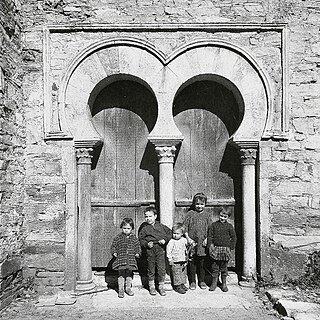
The Mozarabs, or more precisely Andalusi Christians, were the Christians of al-Andalus, or the territories of Iberia under Muslim rule from 711 to 1492. Following the Umayyad conquest of the Visigothic Kingdom in Hispania, the Christian population of much of Iberia came under Muslim control.

Cuenca is a city and municipality of Spain located in the autonomous community of Castilla–La Mancha. It is the capital of the province of Cuenca.

Alcázar de San Juan is a city and municipality of Spain located in the province of Ciudad Real, autonomous community of Castilla–La Mancha. It lies on the plain of La Mancha. From the 13th to the 19th century the history of Alcázar is strongly linked to the Grand Priory of the Order of St. John of Jerusalem. The city became a railway hub in the 19th century.

The Spanish Renaissance was a movement in Spain, emerging from the Italian Renaissance in Italy during the 14th century, that spread to Spain during the 15th and 16th centuries.

The Catedral de la Asunción de la Virgen, popularly known as New Cathedral is, together with the Old Cathedral, one of the two cathedrals of Salamanca, Castile and León, Spain. It is the seat of the diocese of Salamanca. It was constructed between 1533 and 1733 mixing late Gothic, Plateresque and Baroque styles. It was commissioned by Ferdinand V of Castile. It is one of the largest cathedrals in Spain in size and its bell tower, at 92 meters high, is also one of the tallest.

Pre-Romanesque architecture in Asturias is framed between the years 711 and 910, the period of the creation and expansion of the kingdom of Asturias.
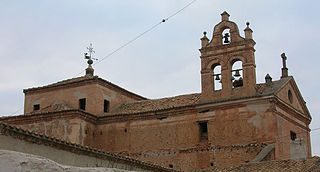
Liétor is a municipality in Albacete, Castile-La Mancha, Spain, located southeast of the Iberian peninsula, in the valley of the "Mundo" river. It has a population of 1,279 inhabitants. It comprises the districts of Cañada de Tobarra, Casablanca, El Ginete, Híjar, Mullidar, Talave and La Alcadima.

The Mosque of Cristo de la Luz is a Catholic chapel and former mosque in Toledo, Spain. It is the one of the ten that existed in the city during the Moorish period. The edifice was then known as Mezquita Bab-al-Mardum, deriving its name from the city gate Bab al-Mardum. It is located near the Puerta del Sol, in an area of the city once called Medina where wealthy Muslims used to live.
Calera de León is a municipality located in the province of Badajoz, Extremadura, Spain. According to the 2008 census (INE), the municipality has a population of 1,070 inhabitants.
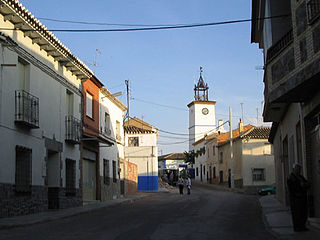
Camuñas is a municipality located in the province of Toledo, Castile-La Mancha, Spain. According to the 2018 census (INE), the municipality had a population of 1,740 inhabitants.

Consuegra is a municipality located in the province of Toledo, Castile-La Mancha, Spain. In 2018, the municipality had a population of 10,098 inhabitants. It is 80 km from Ciudad Real and 60 km from Toledo. Consuegra is located in La Mancha region, famous for its extensive dry plains, vineyards and historical constructions such as windmills.

The Cathedral of Santa María, known as the Old Cathedral, is one of the two cathedrals in Salamanca, Castile and León, Spain. Founded by Bishop Jerome of Périgord, its construction began in the first third of the 12th century and was finished at the end of the 14th century, in Romanesque and Gothic style. It was finished thanks to the impulse given to the works by Bishop Alfonso Barasaque. It is dedicated to Saint Mary of the See.

José Joaquín Álvarez de Toledo y Silva, 18th Duke of Medina Sidonia, GE was a Spanish aristocrat and politician who served as Superior Chief of the Palace from 1885 until his death. He was a knight of the Real Maestranza de Caballería de Sevilla and of the Order of Alcántara.

The Cathedral of Sigüenza, officially Catedral de Santa María de Sigüenza, is the seat of the bishop of Sigüenza, in the town of Sigüenza, in Castile-La Mancha, Spain. It was declared Bien de Interés Cultural in 1931.
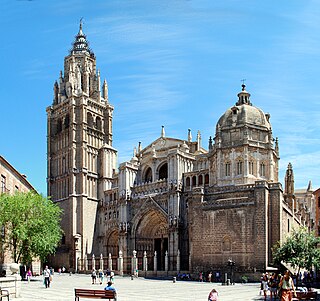
The Primatial Cathedral of Saint Mary of Toledo, otherwise known as Toledo Cathedral, is a Roman Catholic church in Toledo, Spain. It is the seat of the Metropolitan Archdiocese of Toledo.

Alarcón is a municipality in the province of Cuenca, in the autonomous community of Castilla-La Mancha, Spain.

The Iglesia de Santo Tomé is a church located in the historical center of the city of Toledo (Spain), and was founded after the reconquest of this city by King Alfonso VI of León. It appears quoted in the 12th century, as constructed on the site of an old mosque of the 11th century. This mosque, together with other mosques in the city, were used as Christian churches without major changes, since in the taking of the city there was no destruction of buildings.
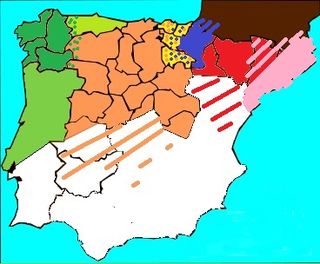
Spanish Romanesque designates the Romanesque art developed in the Hispanic-Christian kingdoms of the Iberian Peninsula in the 11th and 12th centuries. Its stylistic features are essentially common to the European Romanesque although it developed particular characteristics in the different regions of the peninsula. There is no Romanesque art in the southern half of the peninsula because it remained under Muslim rule (Al-Andalus). The examples of Romanesque buildings in the central area of the peninsula are sparse and of the latest period, with virtually no presence south of the Ebro and the Tagus. Most Romanesque buildings can be found in the northern third of the peninsula. Romanesque art was introduced into the peninsula from east to west, so scholars have usually defined regional characteristics accordingly: the "eastern kingdoms" comprising the Pyrenean areas, Catalan Romanesque, Aragonese Romanesque and Navarrese Romanesque, and the "western kingdoms" comprising Castilian-Leonese Romanesque, Asturian Romanesque, Galician Romanesque and Portuguese Romanesque.

The Campo de San Juan was the seigneurial lordship of the Order of St. John in the lands of La Mancha. It was the most important possession of the Grand Priory of the langue of Castile and León. It spanned across territory of the current Spanish provinces of Toledo and Ciudad Real. The most important urban centres were Consuegra and Alcázar de San Juan.




















